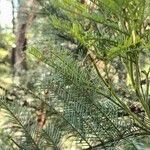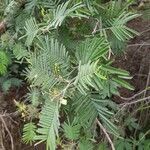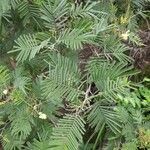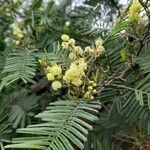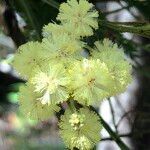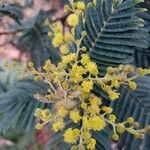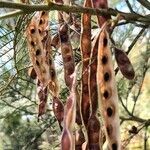An evergreen tree. It grows to 15 m high with a spread of 5 m across. The stem is green and angled. The young branches are winged. The leaves (phyllodes) are dark green and are divided into secondary leaflets. They have a appearance like a feather. The leaves are 8 cm long with 6-12 pairs of larger leaflets and 60-80 smallest leaflets. The flowers are golden yellow balls in a much branched flower. They are 0.5 cm across. They are in They have a sweet smell. Many flowers occur. The pods are long and constricted between the seeds.
Trees, unarmed, 7-15 m tall. Branchlets glabrous, conspicuously angulate. Leaf glands on rachis between leaflets; pinnae (3-)7-15 pairs; leaflets widely spaced, 15-45 pairs, linear, 5-10 × 0.3-0.8 mm, main vein close to upper margin. Heads 6-8 mm in diam., arranged in racemes or panicles. Flowers yellow. Calyx shortly ciliate. Petals with conspicuous midvein. Stamens exserted. Legume oblong, flat, 2-10.5 cm × 4-8.5 mm, almost leathery, constricted between seeds. Seeds ovoid. Fl. Jan-Apr, fr. May-Aug. 2n = 26*.
Unarmed, glabrous, spreading tree to 12 m. Branchlets acutely angular. Leaves bipinnate, rachis 7—12 cm, gland at top of petiole, circular, raised, thiekly rimmed, c. 1 mm diam.; pinnae 6-8(-12) pairs, 3-6 cm; leaflets opposite sessile, 30-40 pairs, widely spaced, linear-filiform, acute, glabrous, 5-10 by 0.5 mm. Inflorescences consisting of 25-30-flowered heads, aggregated in axillary rac mes, exceeding the leaves. Pod oblong, com-pu ssed 5-10 by 0.4-0.7 cm, constricted between the seeds.
